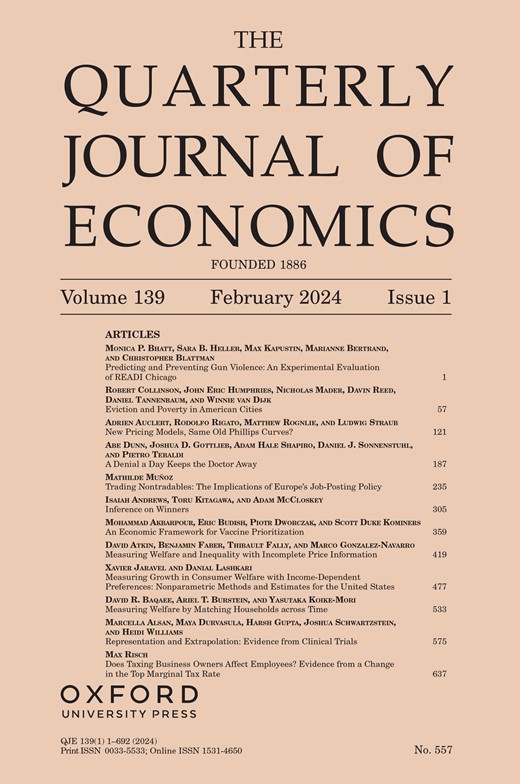亲属关系的经济后果:来自美国禁止表亲结婚的证据
IF 12.7
1区 经济学
Q1 ECONOMICS
引用次数: 6
摘要
近亲婚姻,通过维持紧密的家庭结构,可能阻碍发展。我们用美国各州禁止表亲结婚的禁令来支持这一假设。我们对表亲婚姻的衡量来自于同姓婚姻的过度频率,这是一种借鉴于人口遗传学的方法,我们将其应用于从18世纪到20世纪的数百万份婚姻记录。利用人口普查数据,我们首先表明,已婚表亲更多地来自农村,从事的职业收入较低。然后,我们转向事件研究分析,以了解表亲婚姻禁令如何影响治疗出生队列的结果。我们发现,这些禁令导致来自表亲通婚率高的家庭的个人从农村迁移到城市地区。他们也逐渐转向收入更高的职业。我们还观察到离散性的增加,来自这些家庭的个体生活在更广泛的地方,从事更多样化的职业。我们的研究结果表明,这些变化是由分散的家庭关系的社会和文化影响而不是遗传驱动的。值得注意的是,这些禁令还导致更多的人住在老年人、体弱者或贫困者的机构里,这表明来自亲属的支持减弱了。本文章由计算机程序翻译,如有差异,请以英文原文为准。
Economic Consequences of Kinship: Evidence From U.S. Bans on Cousin Marriage
Close-kin marriage, by sustaining tightly knit family structures, may impede development. We find support for this hypothesis using U.S. state bans on cousin marriage. Our measure of cousin marriage comes from the excess frequency of same-surname marriages, a method borrowed from population genetics that we apply to millions of marriage records from the eighteenth to the twentieth century. Using census data, we first show that married cousins are more rural and have lower-paying occupations. We then turn to an event study analysis to understand how cousin marriage bans affected outcomes for treated birth cohorts. We find that these bans led individuals from families with high rates of cousin marriage to migrate off farms and into urban areas. They also gradually shift to higher-paying occupations. We also observe increased dispersion, with individuals from these families living in a wider range of locations and adopting more diverse occupations. Our findings suggest that these changes were driven by the social and cultural effects of dispersed family ties rather than genetics. Notably, the bans also caused more people to live in institutional settings for the elderly, infirm, or destitute, suggesting weaker support from kin.
求助全文
通过发布文献求助,成功后即可免费获取论文全文。
去求助
来源期刊

Quarterly Journal of Economics
ECONOMICS-
CiteScore
24.20
自引率
2.20%
发文量
42
期刊介绍:
The Quarterly Journal of Economics stands as the oldest professional journal of economics in the English language. Published under the editorial guidance of Harvard University's Department of Economics, it comprehensively covers all aspects of the field. Esteemed by professional and academic economists as well as students worldwide, QJE holds unparalleled value in the economic discourse.
 求助内容:
求助内容: 应助结果提醒方式:
应助结果提醒方式:


